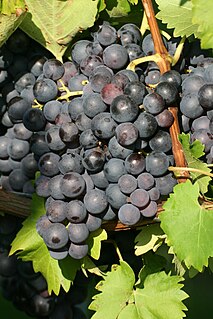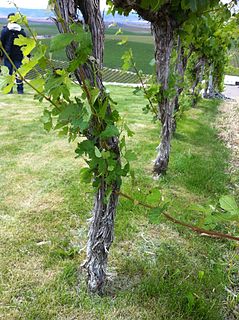
Valpolicella is a viticultural zone of the province of Verona, Italy, east of Lake Garda. The hilly agricultural and marble-quarrying region of small holdings north of the Adige is famous for wine production. Valpolicella ranks just after Chianti in total Italian Denominazione di Origine Controllata (DOC) wine production.

Corvina is an Italian wine grape variety that is sometimes also referred to as Corvina Veronese or Cruina. The total global wine-growing area in 2010 was 7,495 hectares, all of which is grown in the Veneto region of northeast Italy, except for 19 hectares planted in Argentina. Corvina is used with several other grapes to create the light red regional wines Bardolino and Valpolicella that have a mild fruity flavor with hints of almond. These blends include Corvinone, Rondinella, and Molinara, and Rossignola for the latter wine. It is also used for the production of Amarone and Recioto.

Trollinger, Schiava, or Vernatsch, is a red German/Italian wine grape variety that was likely first originally cultivated in the wine regions of South Tyrol and Trentino, but today is almost exclusively cultivated on steep, sunny locations in the Württemberg wine region of Baden-Württemberg. It is primarily known under the synonyms Trollinger in Germany, Vernatsch in South Tyrol and Schiava in other Italian regions. As a table grape the variety is sometimes known as Black Hamburg, which is commonly confused with the similar synonym for Black Muscat—a variety that is actually a cross of Trollinger and Muscat of Alexandria.
Venetian wine is produced in Veneto, a highly productive wine region in north-eastern Italy.

Bardolino and Bardolino Superiore are Italian red wines produced along the chain of morainic hills in the province of Verona to the east of Lake Garda. Bardolino takes its name from the town Bardolino on the shores of Lake Garda and was awarded Denominazione di origine controllata (DOC) status in 1968. The Superiore is a stronger aged wine, and was promoted to Denominazione di origine controllata e garantita (DOCG) status in 2001. The blend of grapes used to produce the wine primarily includes Corvina, Rondinella, and Molinara. Up to 15% of the blend is allowed to include Rossignola, Barbera, Sangiovese, or Garganega, in any combination.

Lombardia (Lombardy) wine is the Italian wine produced in the Lombardy region of north central Italy. The region is known particularly for its sparkling wines made in the Franciacorta and Oltrepò Pavese areas. Lombardy also produces still red, white and rosé wines made from a variety of local and international grapes including Nebbiolo wines in the Valtellina region, Trebbiano di Lugana white wines produced with the Chiaretto style rosé along the shores of Lake Garda. The wine region currently has 15 Denominazione di origine controllata (DOC), 3 Denominazione di Origine Controllata e Garantita (DOCG) and 13 Indicazione Geografica Tipica (IGT) designations. The main cities of the region are Milan, Bergamo and Brescia. The region annually produces around 1.3 million hectolitres of wine, more than the regions of Friuli-Venezia Giulia, Marche, Trentino-Alto Adige/Südtirol and Umbria.
Uva Rara is a red Italian wine grape variety that is grown in the Piedmont and Lombardy wine regions of northern Italy. The grape is a permitted blending variety along with Nebbiolo in the Denominazione di Origine Controllata e Garantita (DOCG) wines of Ghemme. In the Denominazione di Origine Controllata (DOC) wine region of Oltrepò Pavese the grape is often blended with Barbera and Croatina. While Uva Rara's name means "rare grape" in Italian, the variety is actually widely planted with 608 hectares of the vine recorded in Italy in 2000.
Bombino nero is a red Italian wine grape variety that is grown in southern Italy, particularly the regions of Apulia, Basilicata, and Lazio, as well as on the island of Sardinia. It is a permitted grape variety in the Denominazione di origine controllata (DOC) wines of Castel del Monte and Lizzano. The grape is primarily a blending grape but it can also be used as a varietal for red and rosé wines. Though DNA evidence has shown that Bombino nero is not a dark-berried color mutation of the similarly named Bombino bianco, ampelographers still believe that the two varieties are related in some way.
Fortana is a red Italian wine grape variety grown primarily in the Emilia–Romagna region of northern Italy. A permitted grape variety in several Denominazione di origine controllatas (DOCs), mostly in Emilia, Fortana mostly contributes tartness and acidity in red blends.
Brugnola is a red Italian wine grape variety that is grown in the Lombardy wine region of Valtellina. While historically, Brugnola was thought to be a local synonym for Emilia-Romagna wine grape Fortana, DNA analysis has shown that the two grapes are distinct variety and that, instead, Brugnola shares a close genetic relationship with the Piedmont wine grape Nebbiolo.
Pollera nera is a red Italian wine grape variety that is grown primarily in the Liguria wine region and northwest Tuscany. Ampelographers believe that the vine has a very long winemaking history but it is rarely seen today. It is believed to have been descended from the Chianti wine grape Mammolo and the Corsican wine grape Sciacarello which would make it a half-sibling of Colombana nera.

Nosiola is a white Italian wine grape variety that is grown in the Trentino region north of Lake Garda in the Valle dei Laghi. Here it is used in varietal Denominazione di origine controllata (DOC) wines and as a blending component in wines such as Sorni Bianco from Trento. It is also used to produce a dessert wine in the Vin Santo style from grapes that have been allowed to dry out prior to fermentation.
Negrara is a red Italian wine grape variety grown in north east Italy including the Veneto region where it is a permitted variety in the Denominazione di origine controllata (DOC) wine Amarone. While the grape was once more widely planted in the region its numbers have been steadily declining for most of the late 20th and early 21st century.
Rossola nera is a red Italian wine grape variety that has been growing in the Valtellina region of Lombardy since at least the 17th century. In 2004 DNA profiling determined that the grape has a parent-offspring relationship with the Piedmont wine grape Nebbiolo though which variety is the parent and which is the offspring is not yet clear. However, most ampelographers believe that Nebbiolo is likely the parent variety since written records in Piedmont have noted Nebbiolo being grown since at least the 13th century.
Bracciola nera is a red Italian wine grape variety that is primarily found in the Liguria and Toscana wine regions of western Italy. The only Denominazione di origine controllata (DOC) that Bracciola nera plays a significant role is in the Colli di Luni DOC of Ligura where the grape is permitted to be blended with Sangiovese, Canaiolo, Pollera nera, Ciliegiolo, Vermentino nero and other varieties. A late-ripening variety, Bracciola nera usually contributes acidity to blends.
Piccola nera is red Italian and Slovenian wine grape variety that is grown in the province of Trieste within the Friuli-Venezia Giulia wine region and across the border in neighboring Slovenia where ampelographers believe that the grape originated. Piccola nera, whose name means "little black", tends to produce to light bodied red and rosé wines that are meant to be consumed young. It is a permitted variety in the Denominazione di origine controllata (DOC) wines of Carso where it is usually blended with Terrano and in Venezia Indicazione geografica tipica IGT classification where the grape can be used to make varietal wines.

Rossolino nero is a red Italian wine grape variety that is grown in the Valtellina region of Lombardy in northern Italy. The grape was once thought to be a clone of Rossola nera but DNA profiling in the late 20th and early 21st century has shown that the two grapes are distinct varieties but are likely related. Around the village of Teglio, a pink-skinned color mutation of Rossolino nero exist that is known as Rossolino Rosa.
Avarengo is a red Italian wine grape variety that is grown in the Piedmont wine region of northwest Italy where it is a permitted blending component in the Denominazione di origine controllata (DOC) wines of Pinerolese. Here the grape is usually blended with Avanà, Neretta Cuneese and other local red Piemontese varieties.
Bianchetta Trevigiana is a white Italian wine grape variety that is grown in the Trentino-Alto Adige/Südtirol and Veneto wine regions of northeast Italy. Here the grape is rarely used a varietal but, instead, is a permitted blending grape adding acidity to the wines of several Denominazione di Origine Controllata (DOC) zones including the sparkling wine Prosecco and has also been used for vermouth production. The name Trevigiana is derived from the province of Treviso where the grape is believed to have originated from.
Bigolona is a white Italian wine grape variety from the Valpolicella region of northeast Italy where it has been growing since at least the early 19th century. The wine has traditionally been used in the production of late harvest and botrytized dessert wines with the grape's synonym Smarzirola being derived from the Italian marcire meaning "to rot".








